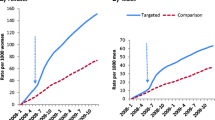Abstract
Summary
To determine whether a process redesign could improve detection and treatment of osteoporosis, at-risk women over the age of 65 were identified using an electronic medical record and proactively contacted by letter and phone call. This resulted in a significant increase in testing for osteoporosis by DXA scan. The high-risk patients were then offered a shared medical appointment, which resulted in improved treatment outcomes compared to usual care.
Introduction
Our objective was to determine if redesigning care through proactive contact with women 65 at-risk of osteoporosis increased BMD testing and to determine if a shared medical appointment (SMA) improved treatment for high-risk women.
Methods
Two primary care sites received the redesign intervention and two other sites served as the usual care controls. At the intervention sites, all women 65 who had not had a DXA scan performed in the prior 2 years were contacted by mail and phone calls. High-risk patients were invited to attend a SMA or follow-up visit with their primary physician.
Results
A significantly higher proportion of women at the intervention sites had a DXA (39.6% vs. 13.2%, p < 0.0001). Patients who attended the SMA were more likely to have calcium and vitamin D recommended, a vitamin D level checked, and receive a prescription medicine than those patients who had follow-up with their primary care physician.
Conclusions
The redesigned process was highly effective in improving BMD testing for women 65. The SMA was shown to be a more effective method to make calcium and vitamin D recommendations, to evaluate secondary causes of low bone density, and to prescribe prescription medications, compared to usual care with the PCP.
Similar content being viewed by others
References
Ross PD, Osteoporosis (1996) Frequency, consequences, and risk factors. Arch Intern Med 156:1399–1411
Lindsay R, Meunier PJ (1998) Osteoporosis: review of the evidence for prevention, diagnosis, and treatment and cost effectiveness analysis. Osteoporosis Int 8(Suppl 4):1–88
U.S. Department of Health ad Human Services, Office of the Surgeon General (2004) Bone health and osteoporosis: a report of the surgeon general
Newman ED, Ayoub WT, Starkey RH et al (2003) Osteoporosis disease management in a rural health care population: hip fracture reduction and reduced costs in postmenopausal women after 5 years. Osteoporos Int 14:146–151
U.S. Preventative Services Task Force (2002) Screening for osteoporosis in postmenopausal women: recommendations and rationale. Ann Intern Med 137:526–528
Hodgson SF, Watts NB, Bilezikian JP et al (2003) American Association of Clinical Endocrinologists medical guidelines for clinical practice for the prevention and treatment of postmenopausal osteoporosis. Endocr Pract 9:544
International Society for Clinical Densitometry (2005) Official Positions. http://www.iscd.org/Visitors/positions/OfficialPositionsText.cfm (Accessed 7/17/06)
National Osteoporosis Foundation (2003) Physician's guide to prevention and treatment of osteoporosis. National Osteoporosis Foundation, Washington, D.C.
www.icsi.org Accessed 7/27/06
Solomon DH, Polinski JM, Truppo C et al (2006) Access to bone mineral density testing in patients at risk for osteoporosis. Osteoporos Int 17:1749–1754
de Lusignan S, van Vlymen J, Hague N et al (2006) Using computers to identify non-compliant people at increased risk of osteoporotic fractures in general practice: a cross-sectional study. Osteoporos Int 17:1808–1814
Harrington JT, Lease J (2008) Osteoporosis disease management for fragility fracture patients: New understandings based on three years’ experience with an osteoporosis care service. Arthritis Rheum 57(8):1502–1506
Kuiken S, Seiffert D (2005) Thinking outside the box! Enhance patient education by using shared medical appointments. Plas Surg Nurs 25(4):191–195
Thacker HL, Maxwell R, Saporito J et al (2005) Shared medical appointments: facilitating interdisciplinary care for midlife women. J Women’s Health 14(9):867–870
Funding
This study was funded by a grant from Procter and Gamble
Conflicts of interest
None.
Author information
Authors and Affiliations
Corresponding author
Rights and permissions
About this article
Cite this article
Ayoub, W.T., Newman, E.D., Blosky, M.A. et al. Improving detection and treatment of osteoporosis: redesigning care using the electronic medical record and shared medical appointments. Osteoporos Int 20, 37–42 (2009). https://doi.org/10.1007/s00198-008-0635-x
Received:
Accepted:
Published:
Issue Date:
DOI: https://doi.org/10.1007/s00198-008-0635-x




